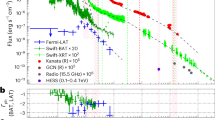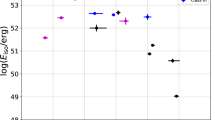Abstract
Cosmic-ray acceleration has been a long-standing mystery1,2 and, despite more than a century of study, we still do not have a complete census of acceleration mechanisms. The collision of strong stellar winds in massive binary systems creates powerful shocks that have been expected to produce high-energy cosmic rays through Fermi acceleration at the shock interface. The accelerated particles should collide with stellar photons or ambient material, producing non-thermal emission observable in X-rays and γ-rays3,4. The supermassive binary star Eta Carinae (η Car) drives the strongest colliding wind shock in the solar neighbourhood5,6. Observations with non-focusing high-energy observatories indicate a high-energy source near η Car, but have been unable to conclusively identify η Car as the source because of their relatively poor angular resolution7,8,9. Here we present direct focussing observations of the non-thermal source in the extremely hard X-ray band, which is found to be spatially coincident with the star within several arc-seconds. These observations show that the source of non-thermal X-rays varies with the orbital phase of the binary, and that the photon index of the emission is similar to that derived through analysis of the γ-ray spectrum. This is conclusive evidence that the high-energy emission indeed originates from non-thermal particles accelerated at colliding wind shocks.
This is a preview of subscription content, access via your institution
Access options
Access Nature and 54 other Nature Portfolio journals
Get Nature+, our best-value online-access subscription
$29.99 / 30 days
cancel any time
Subscribe to this journal
Receive 12 digital issues and online access to articles
$119.00 per year
only $9.92 per issue
Buy this article
- Purchase on Springer Link
- Instant access to full article PDF
Prices may be subject to local taxes which are calculated during checkout



Similar content being viewed by others
References
Koyama, K. et al. Evidence for shock acceleration of high-energy electrons in the supernova remnant SN1006. Nature 378, 255–258 (1995).
Morlino, G. & Caprioli, D. Strong evidence for hadron acceleration in Tycho’s supernova remnant. Astron. Astrophys. 538, A81 (2012).
Pittard, J. M. & Dougherty, S. M. Radio, X-ray, and γ-ray emission models of the colliding-wind binary WR140. Mon. Not. R. Astron. Soc. 372, 801–826 (2006).
De Becker, M., Benaglia, P., Romero, G. E. & Peri, C. S. An investigation into the fraction of particle accelerators among colliding-wind binaries. Towards an extension of the catalogue. Astron. Astrophys. 600, A47 (2017).
Corcoran, M. F. X-ray monitoring of η Carinae: variations on a theme. Astron. J. 129, 2018–2025 (2005).
Groh, J. H., Hillier, D. J., Madura, T. I. & Weigelt, G. On the influence of the companion star in Eta Carinae: 2D radiative transfer modelling of the ultraviolet and optical spectra. Mon. Not. R. Astron. Soc. 423, 1623–1640 (2012).
Leyder, J.-C., Walter, R. & Rauw, G. Hard X-ray emission from η Carinae. Astron. Astrophys. 477, L29–L32 (2008).
Abdo, A. A. et al. Fermi large area telescope observation of a gamma-ray source at the position of Eta Carinae. Astrophys. J. 723, 649–657 (2010).
Sekiguchi, A. et al. Super-hard X-ray emission from η Carinae observed with Suzaku. Publ. Astron. Soc. Jpn 61, 629–637 (2009).
Castor, J. I., Abbott, D. C. & Klein, R. I. Radiation-driven winds in Of stars. Astrophys. J. 195, 157–174 (1975).
Dougherty, S. M. & Williams, P. M. Non-thermal emission in Wolf-Rayet stars: are massive companions required? Mon. Not. R. Astron. Soc. 319, 1005–1010 (2000).
De Becker, M. & Raucq, F. Catalogue of particle-accelerating colliding-wind binaries. Astron. Astrophys. 558, A28 (2013).
Williams, P. M. et al. Radio and infrared structure of the colliding-wind Wolf-Rayet system WR147. Mon. Not. R. Astron. Soc. 289, 10–20 (1997).
Dougherty, S. M., Beasley, A. J., Claussen, M. J., Zauderer, B. A. & Bolingbroke, N. J. High-resolution radio observations of the colliding-wind binary WR 140. Astrophys. J. 623, 447–459 (2005).
Corcoran, M. F. et al. The 2014 X-ray minimum of η Carinae as seen by Swift. Astrophys. J. 838, 45 (2017).
Hillier, D. J., Davidson, K., Ishibashi, K. & Gull, T. On the nature of the central source in η Carinae. Astrophys. J. 553, 837–860 (2001).
Pittard, J. M. & Corcoran, M. F. In hot pursuit of the hidden companion of Eta Carinae: an X-ray determination of the wind parameters. Astron. Astrophys. 383, 636–647 (2002).
Damineli, A. et al. The periodicity of the η Carinae events. Mon. Not. R. Astron. Soc. 384, 1649–1656 (2008).
Hamaguchi, K. et al. Suzaku monitoring of hard X-ray emission from η Carinae over a single binary orbital cycle. Astrophys. J. 795, 119 (2014).
Leyder, J.-C. Walter, R. & Rauw, G. Hard X-ray identification of η Carinae and steadiness close to periastron. Astron. Astrophys. 524, A59 (2010).
Hamaguchi, K. et al. Eta Carinae’s thermal X-ray tail measured with XMM-Newton and NuSTAR. Astrophys. J. 817, 23 (2016).
Tavani, M. et al. Detection of gamma-ray emission from the Eta-Carinae region. Astrophys. J. Lett. 698, L142–L146 (2009).
Leser, E. First results of Eta Car observations with H.E.S.S.II. Preprint at https://arxiv.org/abs/1708.01033 (2017).
Reitberger, K., Reimer, A., Reimer, O. & Takahashi, H. The first full orbit of η Carinae seen by Fermi. Astron. Astrophys. 577, A100 (2015).
Harrison, F. A. et al. The nuclear spectroscopic telescope array (NuSTAR) high-energy X-ray mission. Astrophys. J. 770, 103 (2013).
Jansen, F. et al. XMM-Newton observatory. I. The spacecraft and operations. Astron. Astrophys. 365, L1–L6 (2001).
Hamaguchi, K. et al. X-ray emission from Eta Carinae near Periastron in 2009. I. A two-state solution. Astrophys. J. 784, 125 (2014).
Pittard, J. M., Dougherty, S. M., Coker, R. F., O’Connor, E. & Bolingbroke, N. J. Radio emission models of colliding-wind binary systems. Inclusion of IC cooling. Astron. Astrophys. 446, 1001–1019 (2006).
Farnier, C., Walter, R. & Leyder, J.-C. η Carinae: a very large hadron collider. Astron. Astrophys. 526, A57 (2011).
Ohm, S., Zabalza, V., Hinton, J. A. & Parkin, E. R. On the origin of γ-ray emission in η Carina. Mon. Not. R. Astron. Soc. 449, L132–L136 (2015).
Madsen, K. K. et al. Calibration of the NuSTAR high-energy focusing X-ray telescope. Astrophys. J. Suppl. 220, 8 (2015).
Wik, D. R. et al. NuSTAR observations of the bullet cluster: constraints on inverse Compton emission. Astrophys. J. 792, 48 (2014).
Miyaji, T. et al. The cosmic X-ray background spectrum observed with ROSAT and ASCA. Astron. Astrophys. 334, L13–L16 (1998).
Valinia, A. & Marshall, F. E. RXTE measurement of the diffuse X-ray emission from the galactic ridge: implications for the energetics of the interstellar medium. Astrophys. J. 505, 134–147 (1998).
Ebisawa, K. et al. Chandra deep X-ray observation of a typical galactic plane region and near-infrared identification. Astrophys. J. 635, 214–242 (2005).
Hamaguchi, K., Drake, S. A., Corcoran, M. F., Richardson, N. & Teodoro, M. A gigantic X-ray flare from the star Trumpler 14 Y442 in the Carina star forming complex (The Astronomer’s Telegram 7983, 2015).
Hamaguchi, K. et al. X-ray spectral variation of η Carinae through the 2003 X-ray minimum. Astrophys. J. 663, 522–542 (2007).
Madura, T. I. et al. Constraints on decreases in η Carinae’s mass-loss from 3D hydrodynamic simulations of its binary colliding winds. Mon. Not. R. Astron. Soc. 436, 3820–3855 (2013).
Russell, C. M. P. et al. Modelling the central constant emission X-ray component of η Carinae. Mon. Not. R. Astron. Soc. 458, 2275–2287 (2016).
Corcoran, M. F. et al. Waiting in the wings: reflected X-ray emission from the Homunculus nebula. Astrophys. J. 613, 381–386 (2004).
Aschenbach, B. et al. in SPIE Vol. 4012: X-Ray Optics, Instruments, and Missions III (eds Trümper, J. E. & Aschenbach, B.) 731–739 (2000).
Strüder, L. et al. The European photon imaging camera on XMM-Newton: the pn-CCD camera. Astron. Astrophys. 365, L18–L26 (2001).
Turner, M. J. L. et al. The European photon imaging camera on XMM-Newton: the MOS cameras. Astron. Astrophys. 365, L27–L35 (2001).
Stevens, I. R., Blondin, J. M. & Pollock, A. M. T. Colliding winds from early-type stars in binary systems. Astrophys. J. 386, 265–287 (1992).
Eichler, D. & Usov, V. Particle acceleration and nonthermal radio emission in binaries of early-type stars. Astrophys. J. 402, 271–279 (1993).
Acknowledgements
This research has made use of data obtained from the High Energy Astrophysics Science Archive Research Center (HEASARC), provided by NASA’s Goddard Space Flight Center. This research has made use of NASA’s Astrophysics Data System Bibliographic Services. Resources supporting this work were provided by the NASA High-End Computing (HEC) Program through the NASA Advanced Supercomputing (NAS) Division at Ames Research Center. We appreciate M. Yukita, K. Madsen and M. Stuhlinger on helping resolve the NuSTAR and XMM-Newton data analysis. K.H. is supported by the Chandra grant GO4–15019A, GO7–18012A, the XMM-Newton grant NNX15AK62G, NNX16AN87G, NNX17AE67G, NNX17AE68G, and the ADAP grant NNX15AM96G. C.M.P.R. acknowledges initial support from Chandra Theory grant TM7-18003Z used in combination with an appointment to the NASA Postdoctoral Program at the Goddard Space Flight Center, administered by Universities Space Research Association under contract with NASA, and current support from FONDECYT grant 3170870. A.F.J.M. is supported by NSERC (Canada) and FQRNT (Quebec).
Author information
Authors and Affiliations
Contributions
K.H. and M.F.C. led the project, from proposing and planning observations, analysing the data to composing the manuscript. J.M.P. constructed a theoretical model that explains the variation of the non-thermal component. N.S. performed initial analysis of the NuSTAR data in 2015. H.T analysed and discussed Fermi data of η Car. C.M.P.R. performed theoretical simulations of η Car’s thermal X-ray emission. B.W.G. and D.R.W. discussed NuSTAR data analysis, especially the background characteristics. T.R.G. worked for the observation planning. T.R.G., N.D.R., T.I.M. and A.F.J.M. discussed the wind property of η Car. All authors reviewed the manuscript and discussed the work.
Corresponding author
Ethics declarations
Competing interests
The authors declare no competing interests.
Additional information
Publisher’s note: Springer Nature remains neutral with regard to jurisdictional claims in published maps and institutional affiliations.
Supplementary information
Supplementary Information
Supplementary Figures 1–3, Supplementary Tables 1–2
Rights and permissions
About this article
Cite this article
Hamaguchi, K., Corcoran, M.F., Pittard, J.M. et al. Non-thermal X-rays from colliding wind shock acceleration in the massive binary Eta Carinae. Nat Astron 2, 731–736 (2018). https://doi.org/10.1038/s41550-018-0505-1
Received:
Accepted:
Published:
Issue Date:
DOI: https://doi.org/10.1038/s41550-018-0505-1
This article is cited by
-
Thermal and non-thermal X-ray emission from stellar clusters and superbubbles
Astrophysics and Space Science (2020)



